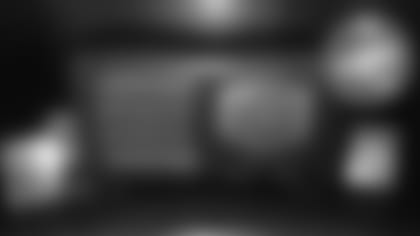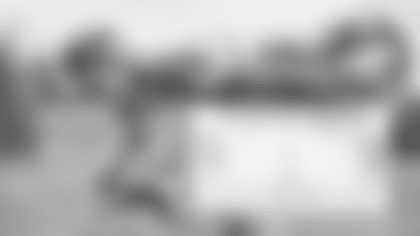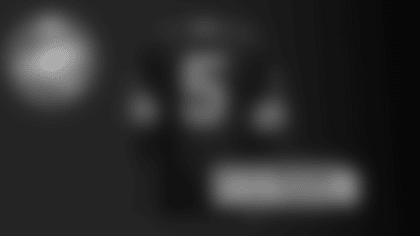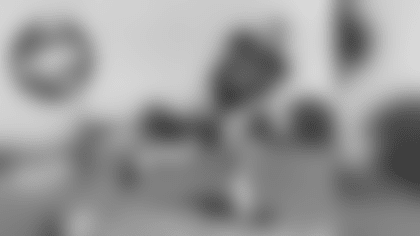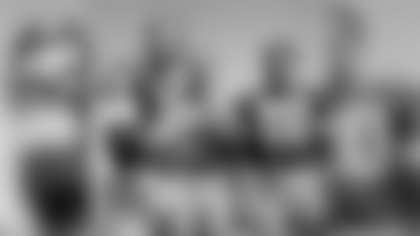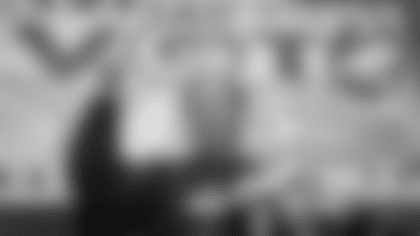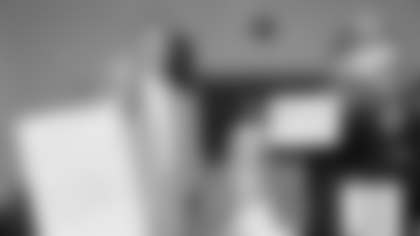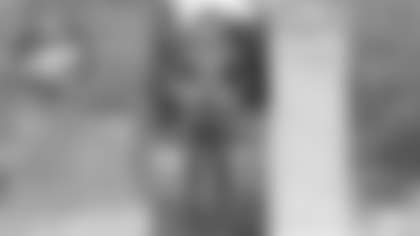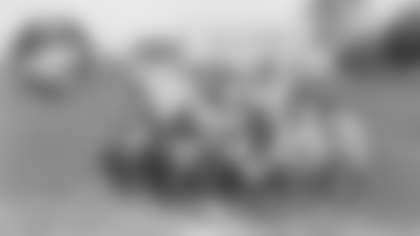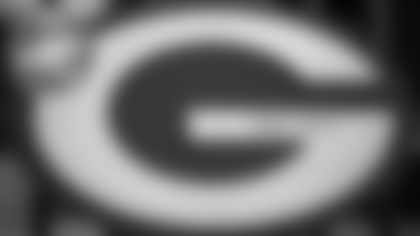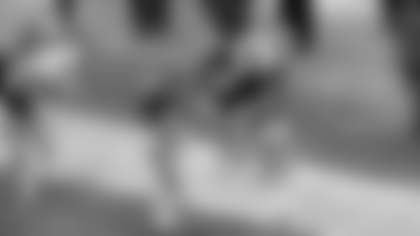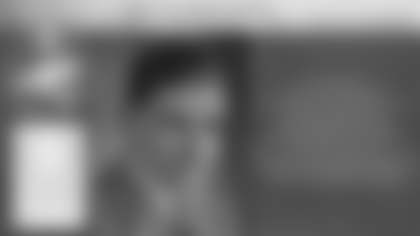Joe from Decorah, IA
I'm restoring an old tube radio to listen to Packers and Brewers games. Next to the radio, I have trading cards of Max McGee and Larry McCarren. This made me wonder if there were other Packers players that served as radio announcers for the team. I welcome any information you can provide.
I believe the first to do it on a regular basis was former defensive end Lionel Aldridge. He worked as an analyst on the Packers' radio broadcasts from 1975-78, preceding McGee.
Otherwise, the earliest reference I found to a player serving as an announcer for a Packers game was in 1930. Tiny Cahoon, a tackle from 1926-29, was supposed to have worked the season opener in 1930 against the Chicago Cardinals, but I don't know for certain that he actually did.
I've also read where Bob Forte, a fan favorite and standout two-way player from 1946-53, worked some games with play-by-play man Earl Gillespie after he retired as a player and that Tom Miller, when he was publicity director of the Packers in the early 1960s, maybe did some "color commentary," as analysts were then described, alongside Ted Moore. Miller played two games as an end with the Packers in 1946.
Russ Winnie, who broadcast the first Packers game on radio in 1929 and continued calling the games through 1946, worked with a spotter that he called "George." Apparently unbeknownst to listeners, "George" was Winnie's wife.
Among the radio play-by-play announcers who followed Winnie were Bob Heiss, Larry Clark, Gillespie, Blaine Walsh, Moore and Gary Bender. But their "color men" were mostly professional announcers: Clark with Heiss; Tony Flynn with Gillespie; Mike Walden and Bill Howard with Walsh; Walsh, Howard and Walden with Moore; and Jim Irwin with Bender. Irwin became play-by-play man in 1975.
Bob Conrad, who had done some scouting for Curly Lambeau, did the color for Clark in 1950.
I also should note that Tony Canadeo served as a regular analyst for Packers games on network TV from 1959-67.
Chuck from Waterloo, WI
With the Packers playing the Giants this past week, my memory was jogged back to 1971. I was a teenager then. In my memory, this was one of the most exciting games I had ever seen. Packers lost to the Giants, 42-40. I remember Ken Ellis returned a missed field goal 100 yards for a touchdown. I also remember there was a safety late in the game to make it close. Do you know anything about this game? Was it as exciting as I remembered?
The game was Dan Devine's head coaching debut with the Packers and is probably best remembered by most of us old enough to have witnessed it for Devine breaking his leg. Not sure if you remember that. But your other recollections suggest you have a good memory.
In the first five minutes of the game, Ellis returned Pete Gogolak's missed field goal 100 yards for a 7-0 Packers lead. And they scored their final points in the last three minutes when safety Doug Hart tackled punter Tom Blanchard in the end zone for a safety following a high snap from center.
Not sure what your definition of an "exciting" game would be, but Lee Remmel's description in his Press-Gazette game story was that "the bizarre was commonplace." Terry Bledsoe of The Milwaukee Journal called it "a contest of ineptitude and error." Also, as you might remember, the game was played in a steady downpour and 53-degree weather in mid-September.
There were 11 touchdowns in all, but the Giants led from the 8 minute, 40 second mark of the second quarter on. Their biggest lead was 21 points, or 28-7, late in the second quarter, and their lead going into the fourth quarter was 42-24.
The "bizarre" part included two Giants touchdowns in the second quarter on fumble recoveries in the end zone. In a span of six seconds, Dave Hampton fumbled twice in the end zone and the Giants recovered: first following a botched exchange of a handoff from quarterback Zeke Bratkowski and then on the ensuing kickoff.
Future Pro Football Hall of Famer Fran Tarkenton was the Giants' quarterback, and he passed for four touchdowns and 236 yards. Two of his touchdown passes followed two other fumbles by the Packers, and another was for 81 yards on the first play following a kickoff.
Besides Ellis' return, the other Packers touchdowns were scored by Hampton on a 19-yard pass from Bratkowski; Rich McGeorge on a 21-yard pass from Scott Hunter on the first play after Hampton returned a kickoff 72 yards; a 19-yard run by halfback Donny Anderson; and a 17-yard pass from Hunter to Carroll Dale following a Hart interception.
The Packers also had the ball at the Giants' 36 with a little more than a minute to go when McGeorge slipped on the wet field and Giants linebacker Jim Files intercepted Hunter's pass. Hunter had replaced Bratkowski at the start of the second half and sparked the Packers' comeback from 14 points down.
Both Devine's tibia and fibula were broken in his left leg on Hart's interception return with a little more than seven minutes remaining in the game. Hart was knocked out of bounds in front of the Packers' bench, and Giants guard Bob Hyland, a former Packer, bowled into him. Devine was taken from the field by ambulance and was on an operating table at Green Bay's St. Vincent Hospital when the game ended.
By the way, the Giants were coming off an 0-6 preseason and won only three more games that year.
Scott from Phoenix, AZ
Do you think Vince Lombardi would have parted with Paul Hornung as part of the "any two players" package for Don Meredith?
Interesting question, Scott. I've wondered that myself. The story about the trade involving Meredith came from Jim Kensil, who was hired as public relations director of the NFL in late February 1961 and claimed Lombardi told him about his proposal just shy of two months later at the NFL's spring meeting in San Francisco. But it wasn't until 18 years later that Kensil shared the story with Dick Young, then sports columnist with the New York Daily News. Perhaps Kensil had told it to other writers prior to then, but the earliest mention I've found of someone writing about Lombardi's interest in Meredith was in 1974, still 13 years after the fact.
Based on a study of human memories that I read, people generally get the gist of long-ago stories right but generally not all the details. Kensil told Young in 1979 that Lombardi had told him off the record after Starr's second season and 13 starts into his regime: "I just made an offer to Dallas. We need a quarterback. I told Tex Schramm (Cowboys GM) he can have any two players on Green Bay for Don Meredith."
Obviously if Kensil remembered word for word what Lombardi had said to him, the answer to your question would be yes.
But there are reasons to question whether Lombardi would have extended the offer of any two players without qualification. He had built his offense around the left halfback just as he had done when he was running the offense in New York, and Hornung had led the Packers in rushing and scoring in 1959 and then set the NFL record for points in a season with 176 in 1960. Additionally, Hornung was a consensus all-pro that year and fullback Jim Taylor made no better than second team.
Clearly, Lombardi was as fond of Hornung as any player on his roster at the time. When Hornung was named athlete of the year in Wisconsin in late January 1960, Lombardi said he deserved the award and added, "I'm sure he can become one of the great players in pro football." Two months later, Lombardi described Hornung at a Milwaukee Press Club luncheon as "fine a young man as I've known" in the league.
Then again, Hornung had injured his shoulder in the 1960 NFL Championship, and it was an injury that would bother him the rest of his career. Lombardi also was extremely high on Tom Moore, his first-round draft pick before the 1960 season and predicted that offseason that he "can become great." The Packers also had drafted Michigan State halfback Herb Adderley in the first round of the 1961 NFL Draft, held in December 1960, and was planning on using him as a hybrid flanker-halfback.
Yet another possibility might have been that Lombardi figured Dallas as a second-year expansion team would pass on Hornung. Prior to their first season, the Cowboys signed their first two players to personal-services contracts without drafting them: Meredith and New Mexico halfback Don Perkins. The 1960 NFL Draft was held on Nov. 30, 1959, two months before Dallas was granted an NFL franchise.
Perkins would miss the 1960 season with an injury, but was ticketed to be their left halfback in 1961. When the Cowboys started, their plan was to build their team around Meredith and Perkins.
John from Burlington, VT
Why did the Packers play the Giants twice in a regular season in the 1970s and Dallas twice in the 1980s? Both Dallas and the Giants are not in the NFC North. Has it happened in other seasons as well?
Your references are to the 1981 and 1989 seasons. In 1981, the Packers played both home and away against the Giants; and the same for the Cowboys in '89. Under the scheduling format used when there were only three divisions and 28 teams, the two fifth-place teams in each conference faced each other twice.
The Packers finished fifth in the NFC Central Division in both 1980 and 1988. The Giants and Cowboys finished fifth in the Eastern Division those respective seasons. The NFC Western Division consisted of only four teams at the time. Those were the only seasons that the Packers finished fifth between 1977 when Tampa Bay was moved to the NFC Central and 1994, the season before the NFL expanded to 30 teams and three five-team divisions. That's why it happened only twice.



